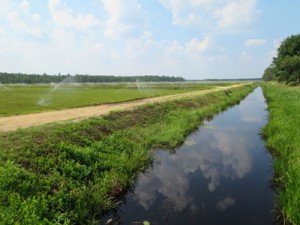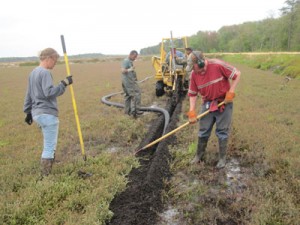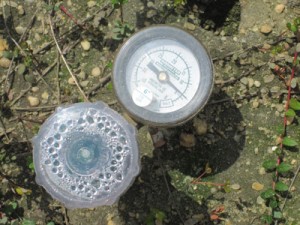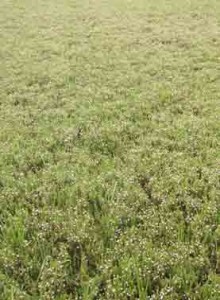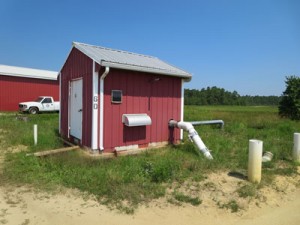Last week we talked about the effect of New Jersey humidity on our growing season and how we set our treatment targets. While we always keep in mind that we are growers first and foremost, one of Pine Island Cranberry’s core values is protecting the environment: caring for the place where we live, work and grow. We do everything we possibly can to limit applications of fungicides.
The first line of defense is maintaining adequate drainage. Per Dr. Peter Oudemans of Rutgers University, uniform drainage helps minimize infection. Puddles or standing water are the first places fungi such as Phytophthora cinnamomi or Phyllosticta occur, and drainage methods that remove standing water (such as installing new underdrain, below) are very useful in controlling root rot.
Over-watering can also increase likelihood of root and fruit rot. In the hot summer months our team works to achieve the delicate balance of cooling off vines while not over-saturating the soil. This requires constant monitoring of tensiometers (pictured below) and lampinenometers to determine soil moisture in the root zone and the distance from the plants to the water table. These readings vary across the farm, making it necessary to use different irrigation regimens from system to system.
When fungicide use is needed, Peter says, “We’ve figured out that if we can treat the disease during the bloom period, we’ve got it seventy to ninety percent controlled. Once the bloom period is over, treatment gives us diminishing returns. Some of our new research is to discover just how much.” He says researchers have been seeing good results with the standard applications discussed by PIICM manager Cristina Tassone last week. “The fungicides used have a narrow spectrum of actions separately, but we’ve found that if they’re combined they can work very well protecting the plants from infection.”
Jeremy Fenstermaker and his team have been up early all week finishing the final application. “It’s usually done early because that’s when it’s calmest,” he says. “It prevents drift and helps give us a more uniform application. The weather’s made it tricky in other ways this year; timing is important so the fungicide has time to dry, which makes it more effective.” Timing is also crucial for running everything through the system. “It varies based on size,” says team member Tim Haines. “Most of them average eight to ten minutes, but some can be as low as four. But as long as the pressure is constant it will be the same every time we run the system.”
Sources:
Oudemans, Peter V. and Anne DeMarsay, Management of Phytophthora Root and Runner Rot in Cranberry, May 2013.

